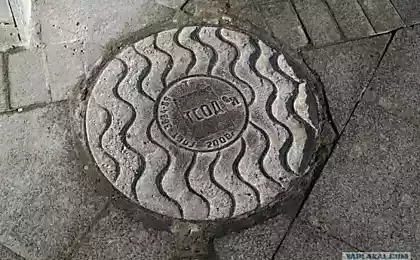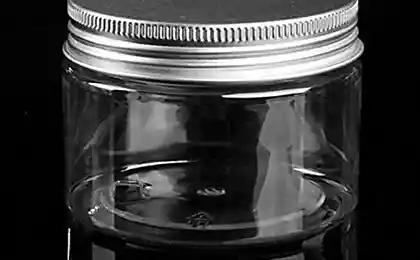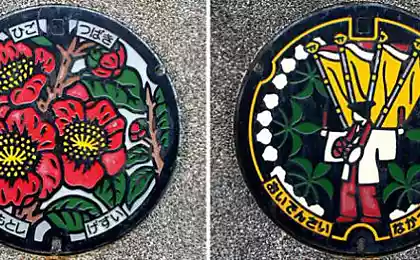910
Manhole covers and their history
Do you often slowly, walk through the city? And how often do you look out for a walk at his feet? And you notice it?
We have long been accustomed to our terrestrial world, which does not pay attention to some things that for us are fairly commonplace and quite everyday. At the moment, I want to talk to you about the underground world. Or rather not even about him, but the "gate" in this world. Namely manholes.
We used to look at them as a technical device, which does not allow a person to fall into the reservoir. Oh, and do not even think about it and, just perceive the hatch, like an ordinary piece of piece of iron weighing 40-50 kg.
However, these covers have a lot to tell. On familiar to us today hatches can read a variety of markings that are deciphered as follows:
K - drainage;
In - water;
D - rainwater drainage;
T - the phone. Sometimes even the designation CTA - urban telephone network.
G - fire hydrant. In my opinion, a column-hydrant would be more convenient for fire calculations.
But it's about modern hatches. Older hatches could reveal to us and other not so obvious information.
12 ph via jedi-rama
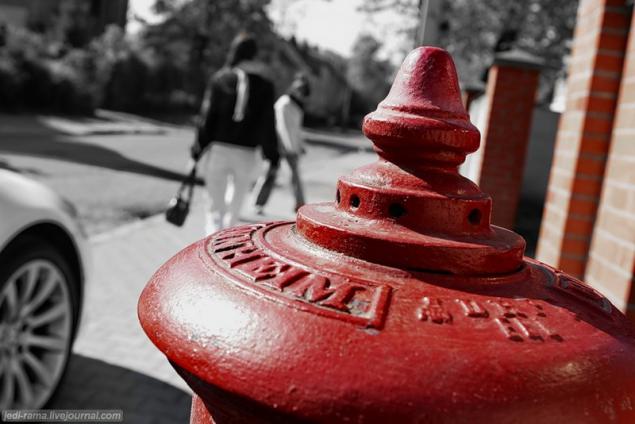
Walking on Kaliningrad, I once noticed a manhole cover beneath their feet. And he gave me very interested. No, not her beauty, but rather the year of production. There was listed number 1927.
But even more I became interested in the inscription WaggonFabrik L.Steinfurt AG this cover. And that's what I found out.
Waggon -Fabrik L.Steinfurt A.G. - The name of the factory where:
L.Steinfurt - the name of the founder of this factory. Leopold Steinfurt.
A.G. here denotes Aktiengesellschaft (later renamed the company Waggon -Fabrik L.Steinfurt Aktiengesellschaft). This term means the organization in the form of a joint stock company.
The plant produced railway and tramway cars, electric vehicles, and iron castings. The first car from the factory came down in 1867.
Also at the wagon factory Steinfurt worked many talented employees, including Karl Scharfenberg (1874 -1938) - the inventor of automatic coupling cars. His engineering discovery proved so successful that today is used in rail vehicles in many countries, including Russia.
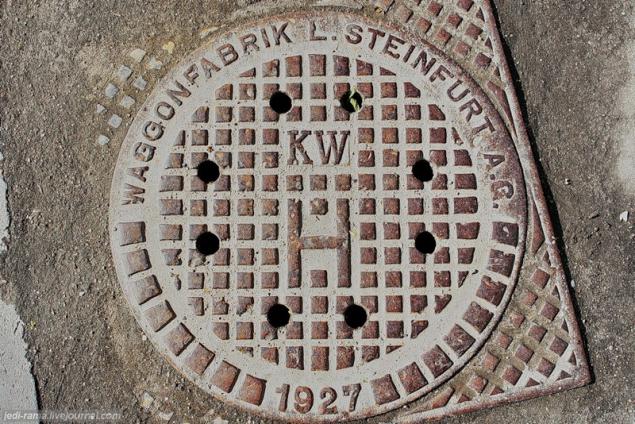
After the death of Leopold Steinfurt in 1864, the factory was headed recently received by him in the service of a talented engineer Fritz Heimann. During his factory received new life. In addition to Fritz he married the daughter of Leopold Steinfurt Steinfurt Laura and received the right to inherit from the obligation to save the name of the test in the name of the company.
When Fritz Heimann 63 years, he decided to retire and pass the matter son Felix (1869-1932), worked as an engineer in Germany.
After the death of Felix Heymann some part in taking his brother Max Heymann (1870 -1939).
Then they participated in the sons Felix Heymann - Friedrich and Max. In the chaos of 1945 they were missing, and the firm has ceased to exist.
Now it just reminds manhole covers on the streets of Kaliningrad.
This is very briefly to the history of this famous company.
The photo below is another hatch of the firm, but the issue in 1937.

And one more, but, unfortunately, without the year.
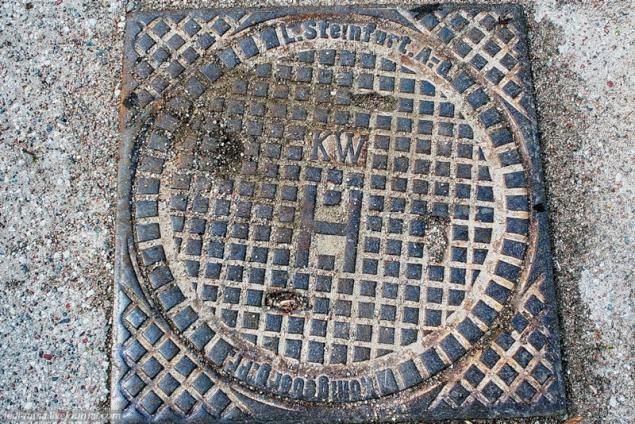
If the inscriptions on the covers higher now everything is clear (except markings KW and H), then that's from the bottom I have a certain discrepancy.
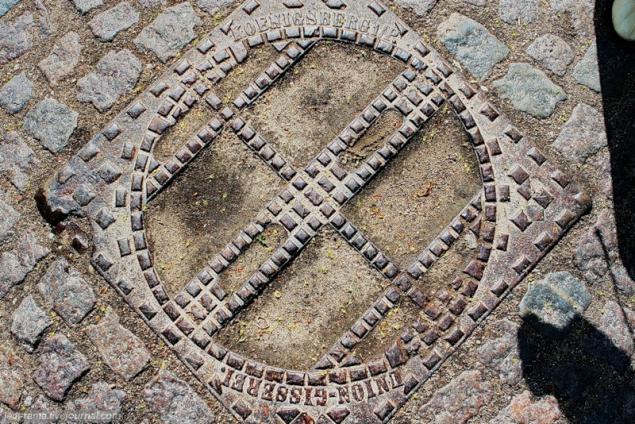
In 1828, in Königsberg families Laubmeyer, Dultz and Schnell was established firm, which in 1845 gave the name Union Giesserei.
Originally it was a foundry.
In 1846, under the control of Johann Gottfried Wilhelm Dietrich Ostendorffa (1812 - 1876) started manufacturing steam engines and boilers.
December 5, 1855 the factory came down the first steam locomotive that was issued to the Prussian Eastern Railway.
After the death of Ostendorffa in 1876, a company headed by Elias Redok (1840-1910) from Berlin.
In the 1920s, the company has considerable economic problems happened because it failed to get contracts with the Deutsche Reichsbahn (German Railways).
But in 1927, under the "help East area» company gave orders for several types of steam locomotives.
After the war, the whole thing turned into a shipyard "Yantar", which is now live.
In the picture below the company's share in denominations of 1,000 marks (100 Reichsmarks), 1921.
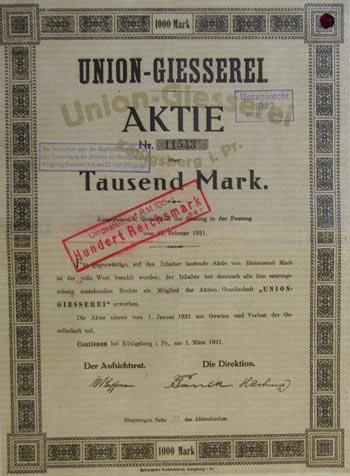
Now look again at the hatch. The name of the company Union Giesserei missed the first letter "e» - Union Gisserei. Here too difficult for me to say something, or it's really a mistake or there is any sense. I do not believe that such a solid company, could allow such a mistake, and in his same name.
About the cover below me, unfortunately, to find anything was not possible. But their story we can replace them with aesthetic value)). For example, here it is very similar to aluminum can with a key-okryvalkoy:

And this simply beautiful
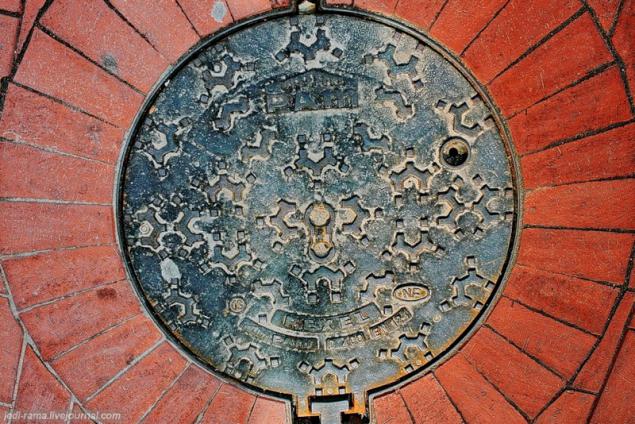
Here's a story of a store inscription on manhole covers in Kaliningrad.
But not only "foreign" lids can read a story. For example, in Khimki (Moscow reg.), Which acquired the status of a city only in 1939, I had found a hatch:
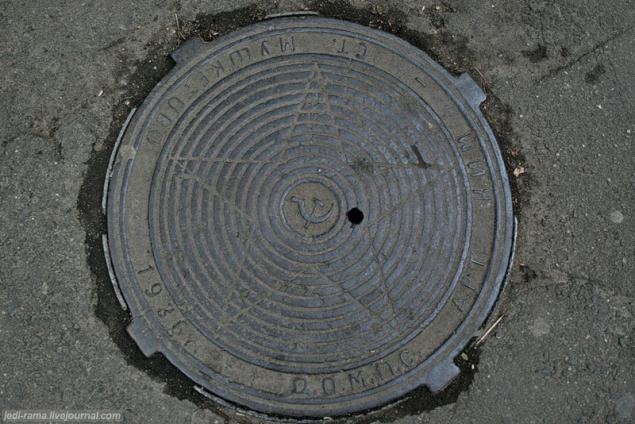
In addition to the 1936 release on it and there is something else which historical information. With the assumption of caution and words ART KIM I deciphered as Artel Communist International Youth.
D.O.M.P.S. probably indicates belonging to the Ministry of Railways. But with the inscription ST. Mushketov everything is transparent enough. This message tells us that this cap got in Khimki from the Donetsk Region (Ukraine).
Mushketov - one of the stations that linked Donetsk with distant industrial areas of the region. From this station, and the station was connected Yuzovo Metallurgical Plant.
And in the historic center of Moscow can be found here is a hatch (Photo Dzhepko LP):
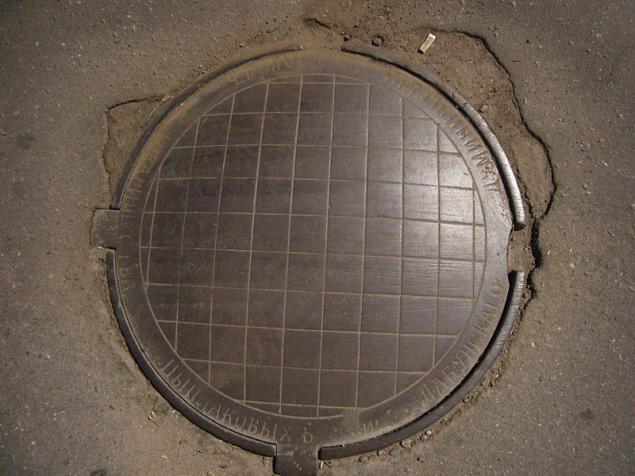
This cover was made at the beginning of the XX century Duminichskim iron foundry partnership Tsyplakova and Labunskiy.
Construction of the plant began in 1883 on the territory of the village Duminichi (Kaluga region).
February 17, 1883 held the first smelting of ore.
The plant had several steam engines and blast furnace. Products produced huge quantities. By the end of 1887 the factory employed 450 male adults and 57 teenagers.
During the Great Patriotic War Duminichskaya land became a place of active hostilities, he acted on its territory partisan group "For the Motherland". The village was twice occupied by the Germans.
The village itself has turned into ruins and iron foundry Tsyplakova was also destroyed.
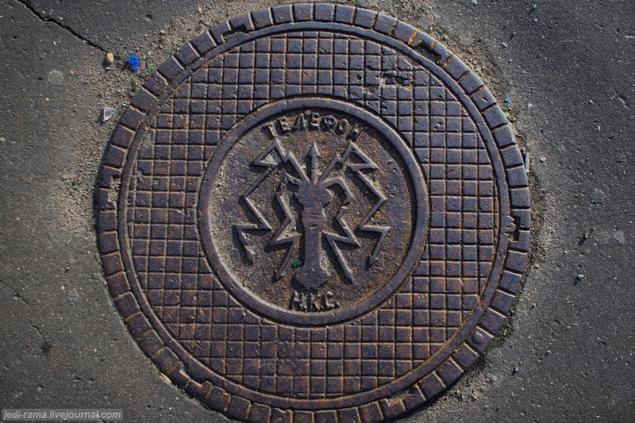
And what you can tell at first glance inconspicuous things?
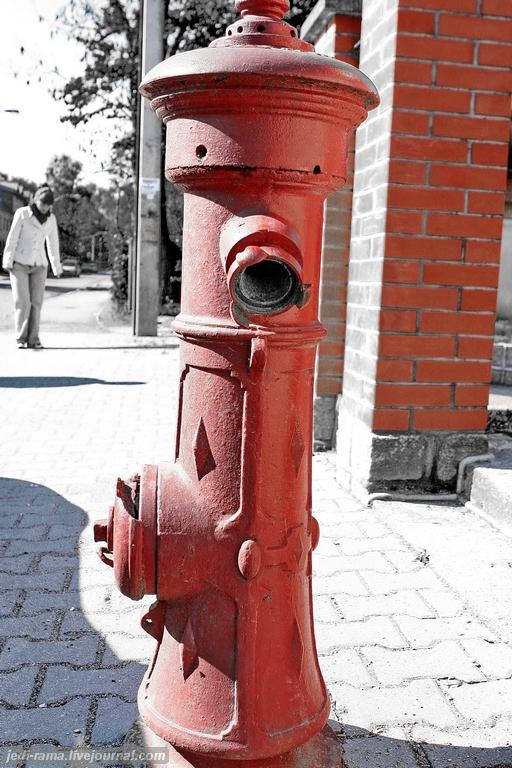
Source:
We have long been accustomed to our terrestrial world, which does not pay attention to some things that for us are fairly commonplace and quite everyday. At the moment, I want to talk to you about the underground world. Or rather not even about him, but the "gate" in this world. Namely manholes.
We used to look at them as a technical device, which does not allow a person to fall into the reservoir. Oh, and do not even think about it and, just perceive the hatch, like an ordinary piece of piece of iron weighing 40-50 kg.
However, these covers have a lot to tell. On familiar to us today hatches can read a variety of markings that are deciphered as follows:
K - drainage;
In - water;
D - rainwater drainage;
T - the phone. Sometimes even the designation CTA - urban telephone network.
G - fire hydrant. In my opinion, a column-hydrant would be more convenient for fire calculations.
But it's about modern hatches. Older hatches could reveal to us and other not so obvious information.
12 ph via jedi-rama

Walking on Kaliningrad, I once noticed a manhole cover beneath their feet. And he gave me very interested. No, not her beauty, but rather the year of production. There was listed number 1927.
But even more I became interested in the inscription WaggonFabrik L.Steinfurt AG this cover. And that's what I found out.
Waggon -Fabrik L.Steinfurt A.G. - The name of the factory where:
L.Steinfurt - the name of the founder of this factory. Leopold Steinfurt.
A.G. here denotes Aktiengesellschaft (later renamed the company Waggon -Fabrik L.Steinfurt Aktiengesellschaft). This term means the organization in the form of a joint stock company.
The plant produced railway and tramway cars, electric vehicles, and iron castings. The first car from the factory came down in 1867.
Also at the wagon factory Steinfurt worked many talented employees, including Karl Scharfenberg (1874 -1938) - the inventor of automatic coupling cars. His engineering discovery proved so successful that today is used in rail vehicles in many countries, including Russia.

After the death of Leopold Steinfurt in 1864, the factory was headed recently received by him in the service of a talented engineer Fritz Heimann. During his factory received new life. In addition to Fritz he married the daughter of Leopold Steinfurt Steinfurt Laura and received the right to inherit from the obligation to save the name of the test in the name of the company.
When Fritz Heimann 63 years, he decided to retire and pass the matter son Felix (1869-1932), worked as an engineer in Germany.
After the death of Felix Heymann some part in taking his brother Max Heymann (1870 -1939).
Then they participated in the sons Felix Heymann - Friedrich and Max. In the chaos of 1945 they were missing, and the firm has ceased to exist.
Now it just reminds manhole covers on the streets of Kaliningrad.
This is very briefly to the history of this famous company.
The photo below is another hatch of the firm, but the issue in 1937.

And one more, but, unfortunately, without the year.

If the inscriptions on the covers higher now everything is clear (except markings KW and H), then that's from the bottom I have a certain discrepancy.

In 1828, in Königsberg families Laubmeyer, Dultz and Schnell was established firm, which in 1845 gave the name Union Giesserei.
Originally it was a foundry.
In 1846, under the control of Johann Gottfried Wilhelm Dietrich Ostendorffa (1812 - 1876) started manufacturing steam engines and boilers.
December 5, 1855 the factory came down the first steam locomotive that was issued to the Prussian Eastern Railway.
After the death of Ostendorffa in 1876, a company headed by Elias Redok (1840-1910) from Berlin.
In the 1920s, the company has considerable economic problems happened because it failed to get contracts with the Deutsche Reichsbahn (German Railways).
But in 1927, under the "help East area» company gave orders for several types of steam locomotives.
After the war, the whole thing turned into a shipyard "Yantar", which is now live.
In the picture below the company's share in denominations of 1,000 marks (100 Reichsmarks), 1921.

Now look again at the hatch. The name of the company Union Giesserei missed the first letter "e» - Union Gisserei. Here too difficult for me to say something, or it's really a mistake or there is any sense. I do not believe that such a solid company, could allow such a mistake, and in his same name.
About the cover below me, unfortunately, to find anything was not possible. But their story we can replace them with aesthetic value)). For example, here it is very similar to aluminum can with a key-okryvalkoy:

And this simply beautiful

Here's a story of a store inscription on manhole covers in Kaliningrad.
But not only "foreign" lids can read a story. For example, in Khimki (Moscow reg.), Which acquired the status of a city only in 1939, I had found a hatch:

In addition to the 1936 release on it and there is something else which historical information. With the assumption of caution and words ART KIM I deciphered as Artel Communist International Youth.
D.O.M.P.S. probably indicates belonging to the Ministry of Railways. But with the inscription ST. Mushketov everything is transparent enough. This message tells us that this cap got in Khimki from the Donetsk Region (Ukraine).
Mushketov - one of the stations that linked Donetsk with distant industrial areas of the region. From this station, and the station was connected Yuzovo Metallurgical Plant.
And in the historic center of Moscow can be found here is a hatch (Photo Dzhepko LP):

This cover was made at the beginning of the XX century Duminichskim iron foundry partnership Tsyplakova and Labunskiy.
Construction of the plant began in 1883 on the territory of the village Duminichi (Kaluga region).
February 17, 1883 held the first smelting of ore.
The plant had several steam engines and blast furnace. Products produced huge quantities. By the end of 1887 the factory employed 450 male adults and 57 teenagers.
During the Great Patriotic War Duminichskaya land became a place of active hostilities, he acted on its territory partisan group "For the Motherland". The village was twice occupied by the Germans.
The village itself has turned into ruins and iron foundry Tsyplakova was also destroyed.

And what you can tell at first glance inconspicuous things?

Source:




